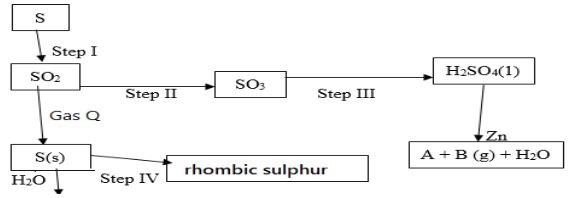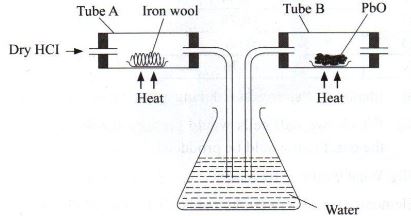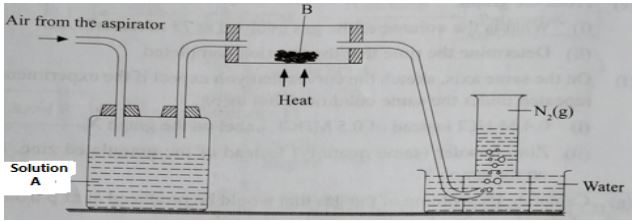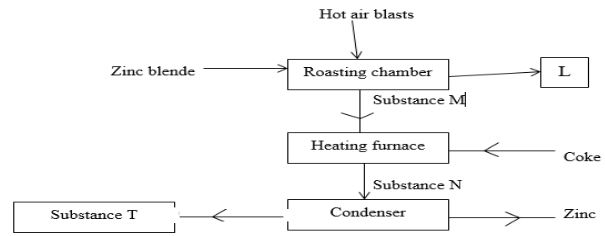Instructions to candidates
- Answer all the questions
- Non-programmable silent electronic calculators and KNEC mathematical tables may be used.
- All working must be clearly shown where necessary.
- Candidates should answer the questions in English.
-
- Detergents are substances that improves cleansing properties of what. Name two substances that are added to detergents to make them more effective in cleansings. (1mark)
- The flow chart below shows steps in the manufacture of soapless detergent. Study it and answer the questions that follow.
- State the condition necessary for Step I. (1mark)
- Write an equation for the reaction in step I (benzene, C6H6 is represented as
). (1 mark)
-
- Name the process in step III. (1mark)
- Give the reagent in step III. (1mark)
- Give the name of the product of step III. (1mark)
- Explain:
- One advantage of soapless detergents over soaps. (1mark)
- One disadvantage of soapless detergents over soaps. (1mark)
- Pentanoic acid reacts with butan-1-ol to form an organic compound.
- What is the name given to the above type of reaction? (1mark)
- A certain catalyst must be added to the mixture to increase the rate of reaction.
Name the catalyst. (1mark)
Explain the role of the catalyst in the above reaction. (1 mark)
- Study the structure below and use it to answer the questions that follows
- State two observations made when the molecule is heated to a temperature of 113°c. (2 marks)
- Write an equation of the reaction between sulphur atom with hydrogen gas. (1mark)
- Below is a flow chart. Use it to answer the questions that follow.
Name: (2 marks)- Gas Q
- Gas B
-
- State the observations made in step I. (2marks)
- Step I and Step II occur in the Contact process. State the optimum conditions necessary for Step II to occur. (2marks)
- Name the reagent used in Step IV. (1 mark)
- Explain why water is not used in Step III. (1 mark)
- Sulphur (iv) oxide is a major environmental pollutant and should not be emitted into the atmosphere. Name the reagent used to achieve this. (1 mark)
- Explain the role of Sulphur in vulcanization of rubber. (1 mark)
- Study the Standard electrode potential for the half-cell given below and use it to answer the questions that follow. The letters do not represent the actual symbols of elements.
E0 (volts)
P+ (aq) + e- → P(s) -2.92 Q+ (aq) + e- → Q (s) +0.52 R+ (aq)+ e- → ½R2 (g) 0.00 S2+(aq) + 2e- → S(s) -0.44 ½T2 (g) + e- → T-(aq) +1.36 - Identify the strongest oxidizing agent. Give a reason for your answer. (2 marks)
- Which half cells would produce the highest potential difference when combined? (1 mark)
- Predict whether the reaction represented below can take place. (2 marks)
S(s) + P+(aq) → S2+(aq) + P(s) - Write a cell representation for the cell that would be constructed by combining P and Q. (2 marks)
- 100 cm3 of 2M sulphuric acid was electrolyzed using the set up represented by the following diagram.
- Write an equation for the reaction that produces gas B.
- Describe how gas A can be identified. (1 mark)
- Explain the differences in the volumes of gases produced at the electrodes. (2 marks)
- An electric current is passed through a solution for 18 minutes. The volume of gas produced at the cathode is 480 cm3.Calculate the current used. (Molar gas volume at rtp = 24 dm3 IF = 96500C) (2 marks)
- In an experiment, dry hydrogen chloride gas was passed through heated iron wool as shown in the diagram below. The gas produced was then passed through heated lead (II) oxide.
-
- State the function of water in the flask. (1 mark)
- Write the equation for the reactions that took place in tubes labeled A and B. (2 marks)
Tube A
Tube B - Explain how the total mass of tube B and its contents would compare before and after the experiment. (2 marks)
- Chlorine gas and hydrogen chloride gas can be prepared using the following reagents: sodium chloride, concentrated Sulphuric (VI) acid and potassium manganate (VII) and hydrochloric acid.
- State the role of each of the following in the reaction. (1 mark)
Concentrated Sulphuric (vi) acid
Potassium manganate VII. (1 mark) - Name the bleaching agent formed when chlorine gas is passed through cold dilute sodium hydroxide solution. (1 mark)
- Apart from bleaching action, state the other use of compound formed in (ii) above. (1 mark)
- State the role of each of the following in the reaction. (1 mark)
- 1.9 g of magnesium chloride were dissolved in water. Silver nitrate solution was then added until in excess. Calculate the mass of AgNO3 that was needed for the complete reaction. (2 marks) (Ag = 108, O = 16, N = 1, Mg = 24, Cl = 35.5)
-
- Use the grid below to answer the questions that follow (the letters do not represent the actual symbols of the elements)
- Give the family name to which elements in the shaded area belong. (1 mark)
- State and explain the difference in reactivity between G and J. (2 marks)
- How does the atomic radius of K compare to that of L? Explain. (2 marks)
- Element R forms an oxide of formula RO2 and it belongs to period 2. Indicate on the grid the position of R. (1mark)
- Give the formula of the compound formed between K and P. (1mark)
- Give the type of bond formed when F reacts with O. Explain. (2 marks)
- Give the electronic arrangements of the ions of G and M. (1mark)
G
M - Element A can fit in two groups. Name the two groups and explain. (2 marks)
- An experiment was carried out using the apparatus as shown below to prepare a sample of nitrogen gas from air.
- Identify one mistake in the setup. (1mark)
- Name what is contained in: (2marks)
- Bottle A ……………………………………………..
- Tube B ………………………………
- The nitrogen prepared by his method is denser than nitrogen prepared by fractional distillation of liquid air. Explain. (1mark)
- Use the flow diagram to answer the questions
- Give the formulae of three gases which can reduce hot copper (II) oxide. (3 marks)
- Explain what will be observed when the above reaction takes place. (1 mark)
- In the Haber process, the optimum yield of ammonia is obtained when a temperature of 450°c,a pressure of 200 atmospheres and an iron catalyst are used.
How is the yield of ammonia affected if the temperature is raised to 600o C. Give a reason? (2marks)
- The flow chart below illustrates extraction of Zinc from zinc blende. Study it and answer the questions that follow
- Give an equation for the reaction in roasting furnace. (1 mark)
- Name each of the substances marked L and N. (2 marks)
- Why is it necessary to condense substance N? (1 mark)
- Which other factory can be set up near the zinc extraction plant. Explain. (2marks)
- Give one use of zinc metal. (1 mark)
-
- Zinc sulphide and sulphuric acid react according to the following equation.:
ZnS(s) H2SO4 → ZnSO4(aq) + H2S(g)
2.91g of zinc sulphide reacted with 100cm3 of 0.2M Sulphuric acid. Determine the reagent that was in excess. (Zn = 65.0, S = 32.0). (2 marks) - Calculate the volume of hydrogen sulphide H2S ) gas produced in the reaction above at rtp.
Molar gas volume 24 dm3) (2 marks)
- Zinc sulphide and sulphuric acid react according to the following equation.:
MARKING SCHEME
-
-
- colors/dyes
- perfumes/ esters 2x½ =1mk
- stabilizers
- tetraoxophosphate
-
- Heating.
-
- Neutralization
- Sodium hydroxide
- Sodium dodecene benzene sulphonate/ sodium alkylbenze sulphonate 1mk
-
- Soapless detergent form compounds salts of calcium and magnesium hence do not form scum with hard water.
- The active ingredients, such as benzene sulphonate are non-biodegradable and they hence accumulate and end up in the bodies of organism.
-
- Esterification
- Conc. Sulphuric acid
- It absorbs the molecules of water formed during the reaction hence forward reaction proceeds to produce water to replace the amount withdrawn.1mk
-
-
-
- Solid melts 1mk
- Forms a clear an amber liquid.1mk
- H2(g) + S(s) → H2S(g) 1mk
-
- Hydrogen sulphide 1mk
- Sulphur (IV) oxide 1mk
-
-
- Blue flame 1mk
- chocking smell.
-
- Temp 450°c
- 2 to 3 atmospheres ( specific pressure in the range)
- V2O5 or Platinum catalyst
- Carbon (iv) sulphide
- A vigorous reaction that produces dangerous poisonous acid mist.
-
- Ca(OH)2(aq) + SO2(g) → CaSO3(ag) + H2O(1)
- It makes the rubber tougher/ less flexible / less soft by reducing the number of double bonds.
-
-
- T2 has the highest electron affinity or it is the most electropositive.
- P and T or P(s)/ P+ (aq)//T-(aq)/½T2(g)
- S(s) + P+(aq) S2+(aq) + P(s)
Solution:
S(s)/S2+(aq)//P+(aq)/P(s)
E.m.f = E red − E oxid
= (−2.92) – (−0.44 )
= − 2.48v
Hence the voltage is –ve and therefore reaction cannot take place. - P(s)|P+(aq) // Q+(aq)| Q(s) = +3.44V 1mk
1mk for calculating the emf (+3.44v) -
- 4OH−(aq) 2H2O(l) + O2(g) + 4e-
- Introduce a burning wooden splint at the mouth of gas jar filled with a gas A. The gas extinguishes a burning splint with a pop sound.
- 2moles of gas A are produced at cathode while only 1 mole of gas B is produced at the anode by the same quantity of electricity. WTTE
- Q = It
24000 cm3 = (2 × 96500) C
480 cm3 = ?
= 2 × 96500 × 480
24000
= 3860C
Q = It but Q = 3860C
3860C = I × 18× 60
I = 3860C
18 × 60
= 3.57 A
-
-
- Water is used to remove excess fumes or unreacted fumes of hydrogen chloride gas.
- A; 2HCl(g) + Fe(s) → FeCl2(aq) + H2(g)
B; PbO(s) + H2(g) → Pb(s) + H2O(g) - Total mass would be lower at the end of the experiment because PbO is reduced to form lead (Pb) and steam (H2O) which escapes air.
-
-
- Conc.Sulphuric acid
- Conc. H2SO4 reacts with NaCl to produce HCL(g)
- Pottasium manganate (VII).
- Used to oxidise HCL(g) to Cl2 (g)
- NaOCl – Sodium hypochlorite
- Use to kill germs or as a disinfectant
-
- MgCl2(aq) + 2AgNO3(aq) → Mg(NO3)2(aq) + 2AgCl(s)
Mole ratio MgCl2 : AgNO3
1 : 2
Moles of MgCl2 = 1.9 = 0.02
95
Moles of AgNO3 = 0.02 × 2 = 0.04 Moles
R.F.M of AgNO3 = 170
Mass of AgNO3 = moles × R.F.M
= 0.04 × 170
= 6.8 g
-
-
- Transition elements
-
- G is more reactive than J
- G requires less energy to lose its one outer electron than 2 electrons for j
- K has a larger atomic radius than L.K has less effective nuclear attraction which makes its radius to be larger than that of L.
-
- KP3
- Ionic bond; F (metal) transfers electrons to O (non metal).
- G: 2.8 ; M: 2.8
-
- Can lose one electron in its outer energy level like members of group 1 to be stable
- Can gain one electron to be stable like members of group VII.
-
- The tube bringing in air should be dipped inside the solution in bottle .
-
- A; NaOH solution
- Tube B : Copper metal
- The nitrogen prepared has impurities which make it denser.
-
- CO , NH3, H2
- Black solid will turn re-brownish; copper (II) oxide will have been reduced to copper.
- The yield is reduced since the reaction is exothermic. Increase in temperature favours backward reaction.
-
- 2ZnS(s) + 3O2(g) → 2ZnO(s) + 2SO2(g)
- L: Sulphuric (IV) oxide N : Zinc vapour
- It produced in vapour state/form.
- Sulphuric (VI) acid manufacturing plant.
To utilize the sulphur (IV) oxide by product. *Any industry that uses SO2 as raw material -
- Galvanization of iron sheets to prevent corrosion/rusting.
- Making brass, an alloy of copper and zinc.
- Making outer casing of dry batteries.
- Zinc cyanide is used for refining silver and gold.
-
- R.F.M ZnS = 97 Sulphuric acid H2SO4
Moles 2.91= 0.03 moles 0.2 mole = 1000cm3
97 ? = 100cm3
100 × 0.2 = 0.02 mole
1000
Zinc sulphide is excess. - 0.02 mole × 24000 = 480cm3
- R.F.M ZnS = 97 Sulphuric acid H2SO4
Download Chemistry Paper 2 Questions and Answers - Lainaku II Joint Mock Examination 2023.
Tap Here to Download for 50/-
Get on WhatsApp for 50/-
Why download?
- ✔ To read offline at any time.
- ✔ To Print at your convenience
- ✔ Share Easily with Friends / Students










